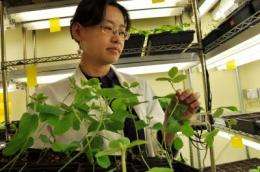How do plants fight disease?

How exactly bacterial pathogens cause diseases in plants remains a mystery and continues to frustrate scientists working to solve this problem. Now Wenbo Ma, a young plant pathologist at the University of California, Riverside, has performed research on the soybean plant in the lab that makes major inroads into our understanding of plant-pathogen interactions, a rapidly developing area among the plant sciences.
Her breakthrough research can help scientists come up with effective strategies to treat crops that have succumbed to disease or, when used as a preventative measure, to greatly reduce their susceptibility to disease.
In a paper published in the March issue of the journal Cell Host & Microbe, Ma, an assistant professor of plant pathology and microbiology, and her colleagues show that the bacterial pathogens target isoflavones, a group of compounds in plant cells that defend the plant from bacterial infection, resulting in a reduction in isoflavone production.
An arms race
First, the pathogens inject virulence bacterial proteins, called HopZ1, through needle-like conduits into the plant cells. These proteins then largely reduce the production of the isoflavones and promote disease development. However, by sensing the presence of HopZ1, the plants mount a robust resistance against the pathogen, including the production of a very high amount of isoflavones. At this point, the pathogen must come up with new strategies by either changing the kind of proteins it injects into the plant, not injecting any proteins at all, or injecting virulence proteins in a way that helps them escape detection by the plant. In this way, the virulence bacterial proteins and the plant host engage in an endless "arms race."
"One question we are still trying to answer is how at the molecular level the bacterial virulence proteins promote disease," Ma said. "Some scientists have shown that these proteins block signaling transduction pathways in the plant, which eventually weakens plant immunity. We are introducing a fresh perspective on this topic, namely, that the pathogens evolved strategies to directly attack the production of plant antimicrobial compounds, such as isoflavones, thus compromising the plant's defense mechanism."
Closing the circle
According to Ma, her results can be extrapolated to understand how plants defend themselves when attacked by pathogens. She is pleased to be resuming research first studied by UC Riverside's Noel Keen, the late plant scientist and a pioneer in molecular plant pathology, who did fundamental groundbreaking work on understanding how isoflavones and isoflavone-derived compounds play a role in defending plants against microbial infection.
"This was an important topic of study about 30 years ago, but then the topic was dropped by researchers and it lost momentum," Ma said. "My lab is now revisiting the problem. Of course, we still have many questions to answer. We need to fully understand how isoflavones function to protect plants so that we can design specific strategies aimed at better protecting the plant."
Looking forward
Ma's lab is also interested in understanding what makes pathogens what they are. Why is it that among ecologically similar bacteria, some cause disease while others do not? Her lab is also studying how plants evolve mechanisms to protect themselves from infection, how pathogens subvert this defense and become virulent again.
"Pathogens get wise to the disease-fighting strategies we use in agriculture," Ma said. "This is evolution at work. But with fundamental knowledge on how pathogens cause disease we can develop sustainable and applicable strategies to combat disease."
More information: www.cell.com/cell-host-microbe … 1931-3128(11)00063-1
Provided by University of California - Riverside
















